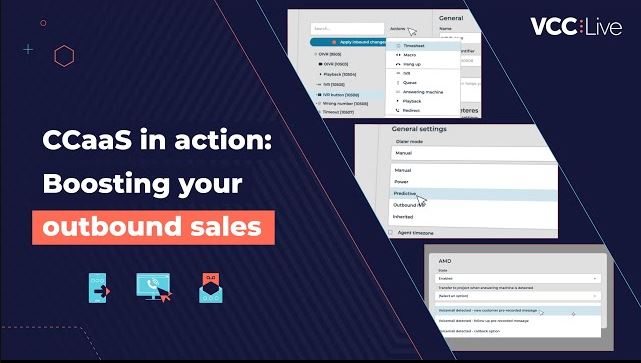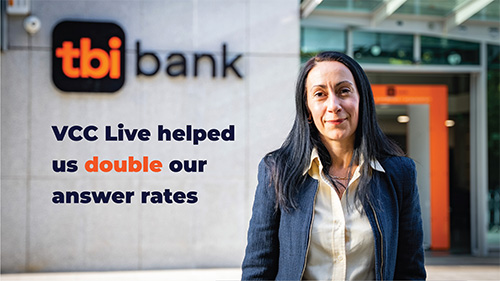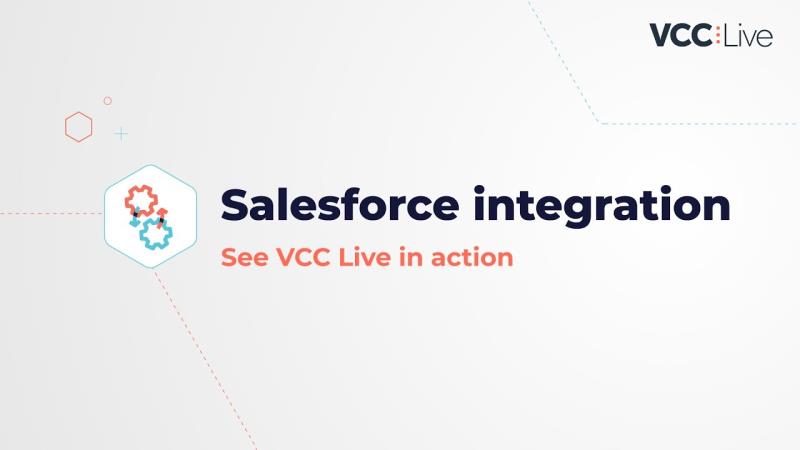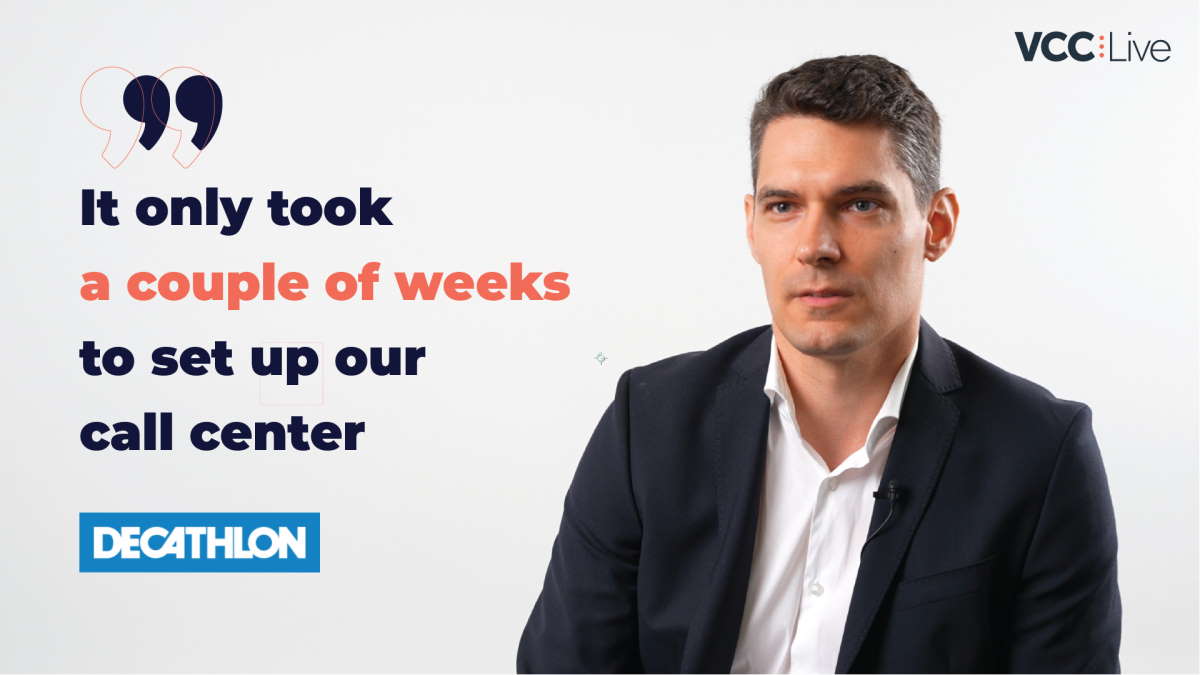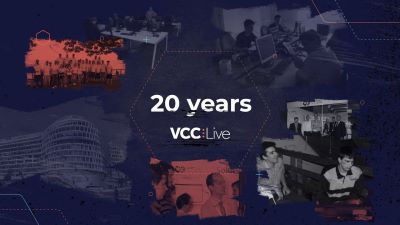Ensuring customer queries are handled within just a single attempt is key to maximizing both customer satisfaction and contact center productivity. Due to this, the concept of First Call Resolution (FCR) has emerged as a convenient and comparable way to track, measure and fine-tune activities in contact centers handling inbound calls, especially for customer service purposes.
Read on as we explore what FCR is, as well as discuss how it’s calculated, what levels of FCR are acceptable, and what to do to improve.
Definition
FCR, or First Call Resolution, is a common metric or KPI used by contact centers to measure the effectiveness of handling incoming queries. Simply put, FCR refers to the ability of a contact center to resolve a customer’s inquiry or issue during their initial contact, without the need for any follow-ups or additional touchpoints, such as calls or extra contacts through other channels. Interestingly, a high level of FCR is beneficial from both points of view: callers and agents. And thus it stands as a cornerstone for delivering exceptional customer experiences and optimizing operational performance.
|
Key components of the FCR metric
When analyzing FCR as a concept, we can highlight quite a few aspects to help you better understand its basics and importance for teams.
• Resolving things on the first try
FCR emphasizes resolving all queries during the very first interaction. The focus is on minimizing the customer’s effort and ensuring a positive experience from the outset. Any subsequent interaction can have a negative effect on the time and quality of the resolution and thus it’s desired to lead the conversation in a way to avoid follow-ups.
• Efficiency and operational effectiveness
Achieving a high FCR rate reflects the efficiency and operational effectiveness of a call center. It indicates that the center has the necessary processes, trained agents, and technological infrastructure to handle a diverse range of customer issues focusing on as fast resolution as possible.
• Customer satisfaction
FCR is closely linked to measuring general customer satisfaction levels. A high FCR rate correlates with accurately meeting customer needs as it demonstrates the call center’s commitment to providing quick and reliable solutions, contributing to positive customer experiences.
• Cost Savings and productivity increase
Multiple interactions for a single issue incur additional costs in terms of agent time, resources, and potential follow-up communications. A good level of FCR not only reduces operational costs but also maximizes the value of each customer interaction, making it a cost-effective approach to customer service. Focusing on FCR is a futureproof approach helping the contact center to gain trust as a go-to source of information, hints, and general help.
Note that a high FCR levels can benefit the team in multiple ways:
- It helps upscaling or downscaling operations depending on peak or quieter times in the contact center.
- It unlocks time for agents to focus on demanding tasks, creative work, or simply handling other queries.
- It makes it easier to predict the typical amount of involvement required to solve a caller’s problem. This makes planning within the team easier.
• FCR formula
FCR is typically calculated as a percentage and is derived by dividing the number of calls or inquiries resolved on the first contact by the total number of calls received, then multiplying by 100. The formula is expressed as:
| FCR = [ |
Number of issues resolved at first attempt |
] * 100 |
| Number of all issues |
Calculating the metric in this way and keeping track of it for a longer period will get you an excellent overview of how successful agents are at meeting the goal. It’ll also create a benchmark for your team, as the typical levels of FCR will differ strongly depending on the characteristics of the target audience, as well as the type of products or services sold.
Putting FCR formula to use – real-life scenario
In a given month, ABC Electronics receives 10,000 customer calls in their contact center. These calls include inquiries about product features, order status, and technical support issues. The contact center tracks the resolution status of each call.
During this month, 8,500 calls were successfully resolved on the first attempt, meaning the customer’s issue was addressed without the need for a callback. Using the FCR formula:
| FCR Rate = [ |
8,500 |
] * 100 |
| 10,000 |
Equals = 85%
Analysis:
The contact center achieved an FCR rate of 85% for the month. This high FCR rate indicates that the majority of customer issues were resolved during the initial call, reflecting positively on customer satisfaction and operational efficiency.
|
Why FCR Matters
There are plenty of reasons why FCR is such an important metric and they will vary depending on the particular use case. It’s importance may of course be a lot lower for contact centers that typically deal with complex, multi-level issues that may even be impossible to solve during the first attempt. That being said, in many cases a high level of FCR can directly affect the following aspects of the business:
• Customer satisfaction and NPS
FCR is intrinsically tied to CSAT or customer satisfaction levels. Resolving issues on the first call demonstrates a commitment to meeting customer needs promptly, leading to higher satisfaction levels. Satisfied customers are more likely to remain loyal and become advocates for your brand.
Therefore it can also lead to higher NPS (Net Promoter Score) levels which indicate how likely it is for a customer to recommend the business (product or service) to their peers. Similarly to what was previously said, FCR is likely to be a lot more important for businesses dealing with a lot of customer queries.
• Productivity
Achieving FCR is not just about satisfying customers; it also reflects the efficiency of your contact center. Resolving issues in the first interaction reduces the workload on agents, minimizes call volume, and frees up resources for handling new inquiries, as well as focusing on other issues. This directly contributes to improved operational efficiency.
What FCR levels are acceptable at a contact center
What constitutes a “good” FCR level can depend on various factors, including the industry, type of inquiries, the audience, and the complexity of the issues being handled. In general, a higher FCR is desirable, as it indicates that customer issues are being resolved efficiently and effectively during the initial contact.
While specific benchmarks may vary, a commonly accepted target for FCR is often around 70% to 80%. Achieving and maintaining a FCR within this range is generally considered good, and it suggests that a significant majority of customer issues are being resolved on the first interaction.
Benchmark
Acceptable FCR levels in contact centers are as high as 70% to 80%. This means that the goal is for only 20-30% of customer queries to require ANY follow-up activities.
|
However, it’s crucial to note that the definition and measurement of FCR can vary among organizations. Some contact centers might have more complex issues that make achieving a high FCR more challenging. Additionally, certain industries may have different expectations or standards for what constitutes a good FCR level. In some cases there are other important customer service metrics that may play a more important role than FCR. These include, for example, Average Handling Time (AHT), abandonment rate, or a more general metric called Service Level typically referring to more than one KPI.
Contact centers that should emphasize FCR
Customer-centric industries:
Businesses in industries where customer satisfaction is paramount, such as retail, hospitality, and e-commerce, should prioritize FCR. Satisfied customers are more likely to remain loyal and recommend the company to others.
Service-oriented businesses:
Contact centers that primarily handle service-related issues should focus heavily on FCR. Resolving customer issues on the first call reduces the need for follow-up interactions, improving overall efficiency.
Subscription-based services:
Companies offering subscription-based services, where customer retention is crucial, should prioritize FCR. Quick issue resolution contributes to a positive customer experience, reducing the likelihood of cancellations.
High-volume call centers:
Contact centers with a high volume of incoming calls should aim for high FCR to manage the workload effectively and prevent bottlenecks in the customer service process.
Contact centers with less emphasis on FCR:
Transactional businesses:
In some industries, like online retail or e-commerce, where interactions are often transactional and do not involve complex issues, the emphasis on FCR may be lower. However, a quick resolution is still desirable.
Specialized technical support:
Contact centers providing highly specialized technical support may prioritize expertise and accuracy over immediate resolution. In such cases, customers may understand that certain issues require additional time and expertise.
Inquiry-based support:
Contact centers that primarily handle general inquiries or non-urgent matters may have a lower emphasis on FCR. The focus might be on providing accurate information rather than immediate resolution.
Proactive customer engagement centers:
Contact centers that focus on proactive customer engagement, such as outbound sales or marketing, may have less emphasis on FCR, as their primary goal is not issue resolution but rather customer outreach and relationship building.
|
Regardless of the specific target, it’s important for contact centers to regularly monitor and analyze their FCR rates, identify reasons for repeat contacts or escalations, and implement improvements to enhance overall customer satisfaction and overall efficiency. Continuous improvement efforts should be based on a thorough understanding of customer needs and feedback.
How to improve FCR levels
FCR, like plenty of other metrics, can be directly influenced by undertaking well thought-out actions changing some processes within the team and its capabilities. Below is a list of options to consider that may have a significantly high impact on this particular metric.
• Invest in comprehensive agent training
Well-trained agents form the backbone of FCR success. Provide extensive training to agents on product knowledge, effective communication, and problem-solving skills. Regular training sessions, workshops, and knowledge-sharing platforms keep agents updated on the latest information, ensuring they are well-equipped to address diverse customer issues.
• Implement intelligent call routing
Utilize advanced call routing systems that direct incoming calls to the most appropriate agents based on their skills and expertise. Intelligent routing ensures that customers are connected to agents who are best suited to handle their specific inquiries, increasing the likelihood of resolving issues on the first call.
• Finetune agent scripts with customizable editors
Most contact centers use some form of scripts but sometimes they may lack in exploiting all possibilities that today’s technologies allow. The script can include interactive step-by-step guides that dynamically change depending on the caller’s responses. Data entered by agents can be dynamically verified against existing data entries to avoid data inconsistencies that may cause issues while resolving future issues. Scripts can also give agents tools available directly inside the contact center software which will help resolve the issue on the first attempt.
• Empower agents with integrations
Bear in mind that scripts can let agents quickly and dynamically access other integrated solutions your team has access to that can massively speed up the time it takes to resolve an issue. Integrated customer relationship management (CRM) systems, knowledge bases, and automation tools enable agents to access relevant information efficiently using a single platform, without switching between tabs, streamlining the problem-solving process.
• Establish a knowledge base
Create and maintain a comprehensive knowledge base that agents can reference during customer interactions. The knowledge base should encompass FAQs, troubleshooting guides, and solutions to common issues. Regularly update the knowledge base to ensure its relevance and accuracy.
• Encourage effective communication
Effective communication is fundamental to resolving issues on the first call. Train agents to actively listen to customers, ask probing questions to gather necessary information, and communicate solutions clearly and concisely. Empathy and courtesy play crucial roles in creating positive interactions.
• Utilize customer feedback
Gather and analyze customer feedback to identify areas for improvement. Understand recurring issues and pain points by leveraging feedback mechanisms such as surveys, customer reviews, and post-call surveys. Use this valuable information to refine processes and enhance FCR rates.
• Implement real-time monitoring
Implement real-time monitoring tools to observe and assess agent performance during live interactions. Supervisors can provide immediate guidance and support to agents, ensuring that they have the resources and assistance needed to resolve issues promptly.
• Set realistic performance targets
Establish realistic FCR targets based on industry benchmarks and the nature of your business. Monitor performance regularly and provide feedback to agents. Recognize and reward achievements to motivate agents and foster a culture of continuous improvement.
• Encourage cross-training
Facilitate cross-training initiatives to broaden the skill sets of agents. Cross-trained agents can handle a wider range of issues, reducing the need for transfers and escalating calls to specialized teams. This versatility contributes to higher FCR rates.
Typical mistakes related to measuring FCR and how to avoid them
FCR can be less of a priority in many call centers where subsequent touchpoints are totally okay to happen or even desired. The biggest issue is when there’s a strong demand to reduce the number of contacts with callers and yet the FCR metric is nowhere close to optimal. There are various reasons why this may be true.
1. Inadequate agent training
Issue: Knowing the product in-and-out, also from a practical standpoint is key for agents to truly understand the roots of the issue. When agents may lack sufficient training on products, services, or procedures, one of the likely outcomes is just being unable to resolve issues on the first call.
Solution: Agents need to know the product or service from the most practical point of view so that potential issues raised are never a surprise. One of the key tactics is to ensure agents actually use the product or service themselves to experience some of the same issues as their callers have.
2. Insufficient knowledge base that’s not easy to search
Issue: Lack of a centralized and comprehensive knowledge base can hinder agents from accessing relevant information quickly. It’s likely that most issues raised are not new, so a database of templates can be helpful too.
Solution: Develop and maintain a robust knowledge base with up-to-date information, as well as real-life issue examples and answer templates that agents can easily access and quickly search through during calls.
3. Ineffective communication channels
Issue: If customers are unable to reach the right department or communicate their issues through various channels, FCR can be compromised.
Solution: Most businesses use more than one channel but it’s key to use the right ones and to put a lot of effort in polishing how they’re used. Implement an omnichannel strategy to make sure customers use the channels that are the most adequate and effective in their case. Deciding which channels to focus on should depend on a number of factors, such as the audience’s characteristics, geographic location, or customer preferences that can be verified through surveys.
4. Flawed FCR measurement methodology skewing the results
Issue: While the formula for FCR is pretty straightforward, FCR can still be measured incorrectly leading to misinterpretation of performance.
Solution: Bear in mind that subsequent touch points may happen due to the nature of communication format and etiquette used. In an ideal scenario, these cases where more than one contact is desired should be filtered out to see the full picture. Regularly review and adjust FCR metrics to ensure they accurately reflect the percentage of issues resolved on the first contact. Consider customer feedback as part of the evaluation process.
5. Inadequate and outdated tools
Issue: Outdated or inefficient contact center software and tools can slow down the issue resolution process leading to more touchpoints than needed. The result can lead to putting callers on hold for too long due to system failures and outdated solutions lacking proper integrations with other systems the company uses, such as CRMs, ERPs, payment gateways, etc.
Solution: Invest in modern, integrated technology that facilitates quick access to customer information and supports efficient communication between agents and departments. Focus on how good systems used are at “talking” to each other to ensure switching between tabs and app windows happens as rarely as possible.
6. Lack of regular call routing analysis and updates
Issue: Inaccurate or inefficient call routing can result in customers being transferred multiple times before reaching a resolution.
Solution: Call routing strategies are never one-size-fits all and they often require constant adjustments and edits depending on how the team grows and how the product and audience change. To prevent this, it’s good to implement a routine in which routing strategies are regularly analyzed to ensure the logic is optimal. To fully understand the caller’s experience it can be helpful to run multiple IVR tests simulating various times and days.
Keep an eye on your FCR levels with a customizable dashboard
Robust contact center software allow teams to track their performance on multiple levels, for example separating projects, teams, and use cases to avoid seeing noise in the data. For example, if a team is focused on dealing with the most complex matters raised by VIP-type clients, the FCR levels may be exceptionally low. But in this case, it’s a fully expected and maybe even desired result. Filtering out these rare cases is key to ensuring you have a solid understanding of how performant the team is.
